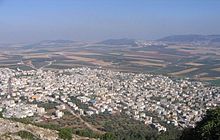Iksal
Iksal (arabisk إكسال, Iksal; hebraisk אִכְּסָאל, כִּסְלוֹת תָּבוֹר, Kislot Tavor[3]) er ein arabisk lokal kommune nord i Israel, kring 5 km søraust for Nasaret.[4] Han har eit folketal på 13 007, hovudsakleg muslimar. Namnet på byen trur ein kjem frå Chesulloth (Chisloth-Tabor), ein bibelsk by nemnt i Josvas bok.[4][5]
| Iksal | |||
| אִכְּסָל, אכסאל, כִּסְלוֹת תָּבוֹר, إكسال | |||
| lokal kommune | |||
Iksal, som sett frå Nasaret Illit
| |||
| Namneopphav: frå Iksal, eit førenamn[1] | |||
| Land | |||
|---|---|---|---|
| Distrikt | Nord distrikt | ||
| Koordinatar | 32°41′N 35°19′E / 32.683°N 35.317°E | ||
| Areal | 9,0 km² | ||
| Folketal | 13 007 (2012)[2] | ||
| Folketettleik | 1 445 / km² | ||
 Iksal 32°40′57″N 35°19′28″E / 32.6825°N 35.324444444444°E | |||
| Wikimedia Commons: Iksal | |||
| Nettstad: موقع إكسال مدرسة إكسال الثانوية مدرسة إكسال الإعدادية | |||
Historie
endreIksal vart av Josefus kalla Xaloth.[6]
I 536 vart det halde eit råd i Jerusalem for å fordømme erkekjettaren Severus og følgjarane hans. I rådet var 45 biskopar frå Palestina, inkludert ein Parthenius, biskopen av Exalus, som er identifisert som Iksal.[7] Dermed veit ein at byen hadde nok kristne på 500-talet til å få ein biskop.
Den 22. desember 946 slo styrkane til det egyptiske Ikhshidid-dynastiet styrkane til Sayf al-Daula ved Iksal. Sistnemnde trekte seg attende til Aleppo, medan Ikshidid-styrkane rykka fram mot Damaskus.[8]
I krossfarartida eller mamelukkstyret i Palestina, vart det bygd ei borg i Iksal, og ruinane er framleis synlege i dag.[9]
Som så mange andre arabiske byar og landsbyar i Galilea som vart ståande etter den arabisk-israelske krigen i 1948, overgav Iksal seg til israelske styrkar utan kamp. Folk som hadde samarbeidd med sionistar før Israel vart oppretta, forhandla vilkåra i overgjevinga og overføringa til eit styre under den nye militære regjeringa.[10]
Arkeologi
endreArkeologiske utgravingar i Iksal har avdekka gjenstandar frå romartida og bysantinsk styre i Palestina.[9]
Sjå òg
endreKjelder
endre- Denne artikkelen bygger på «Iksal» frå Wikipedia på engelsk, den 6. desember 2014.
- Wikipedia på engelsk oppgav desse kjeldene:
- Aharoni, Yohanan (1979). The land of Bibelen: a historical geography (2nd, illustrated, revised utg.). Westminster John Knox Press. ISBN 0-664-24266-9.
- Alexandre, Yardenna (26. mars 2008), Iksal Preliminary Report, Hadashot Arkheologiyot – Excavations and Surveys i Israel, arkivert frå originalen 18. mai 2013, henta 6. desember 2014
- Alexandre, Yardenna (29. august 2011), Iksal Preliminary Report, Hadashot Arkheologiyot – Excavations and Surveys i Israel, arkivert frå originalen 18. mai 2013, henta 6. desember 2014
- Armstrong, George (2009). Names and Places i Gamletestamentet and Apocrypha. BiblioBazaar, LLC. ISBN 1-103-29324-9.
- Chancey, Mark A. (2005). Greco-romersk culture and the Galilea of Jesus (Illustrated utg.). Cambridge University Press. ISBN 0-521-84647-1.
- Conder, Claude Reignier; Kitchener, Herbert H. (1881). The Survey of Western Palestine: Memoirs of the Topography, Orography, Hydrography, and Archeology 1. London: Committee of the Palestine Exploration Fund. s. 363. 366, 385
- Cohen, Hillel (2010). Good arabarar: The israelske Security Agencies and the israelske arabarar, 1948-1967. University of California Press. ISBN 0-520-25767-7.
- Cushner, Kenneth (2004). Beyond tourism: a practical guide to meaningful educational travel. Rowman & Littlefield. ISBN 1-57886-154-3.
- Dauphin, Claudine (1998). La Palestina byzantine, Peuplement et Populations, Vol. III : Catalogue. BAR International Series 726. Oxford: Archeopress. s.730
- Freedman, David Noel; Myers, Allen C.; Beck, Astrid B. (2000). Eerdmans dictionary of Bibelen (Illustrated utg.). Wm. B. Eerdmans Publishing. ISBN 0-8028-2400-5.
- Gil, Moshe (1997). A history of Palestine, 634-1099. Cambridge University Press. ISBN 0-521-59984-9.
- Guérin, Victor (1880). Description Géographique Historique et Archéologique de la Palestina. Vol 3; Galilea, pt. 1. s.108-109
- Hadawi, Sami (1970), Village Statistics of 1945: A Classification of Land and Area ownership in Palestine, Palestinsk frigjeringsorganisasjon forskingssentral s.62[daud lenkje]
- Hütteroth, Wolf-Dieter; Abdulfattah, Kamal (1977). Historical Geography of Palestine, Transjordan and South Syria in the Late 16th Century. Erlanger Geographische Arbeiten, Sonderband 5. Erlangen, Tyskland: Vorstand der Fränkischen Geographischen Gesellschaft. ISBN 3-920405-41-2. s. 187
- Mills, E., red. (1932). Census of Palestine 1931. Population of Villages, Towns and Administrative Areas (PDF). Jerusalem: Government of Palestina.
- Mokary, Abdalla (23. juni 2011), Iksal Preliminary Report, Hadashot Arkheologiyot – Excavations and Surveys i Israel, arkivert frå originalen 18. mai 2013, henta 6. desember 2014
- Palmer, E. H. (1881). The Survey of Western Palestine: Arabic and English Name Lists Collected During the Survey by Lieutenants Conder and Kitchener, R. E. Transliterated and Explained by E.H. Palmer. Committee of the Palestine Exploration Fund.
- Tristram, H. B. (1865): The land of Israel: Travels in Palestina. s. 124
- ↑ Palmer, 1881, s. 126
- ↑ «Locality File» (XLS). Israelsk statistisk sentralbyrå. 2012. Henta 21. november 2014.
- ↑ HaReuveni, Immanuel (1999). Lexicon of the Land of Israel. Miskal - Yedioth Ahronoth Books and Chemed Books. s. 37. ISBN 965-448-413-7. (he)
- ↑ 4,0 4,1 Freedman et al, 2000, s. 236.
- ↑ Aharoni, 1979, s. 120, 257.
- ↑ Armstrong, 2009, s. 42.
- ↑ Bagatti, Bellarmino (2001). Ancient Christian Villages of Galilea. Jerusalem: Franiscan press. s. 217.
- ↑ Gil, 1997, s. 319-320.
- ↑ 9,0 9,1 Yardenna Alexandre (September 26, 2008). «Iksal: Final Report». Hadashot Arkheologiyot: Excavations and Surveys i Israel (Israel Antiquities Authority) (Journal 120). Arkivert frå originalen 18. mai 2013. Henta 6. desember 2014.
- ↑ Cohen, 2010, s. 17.
Bakgrunnsstoff
endre- Velkomen til Iksal ved palestineremembered.com


